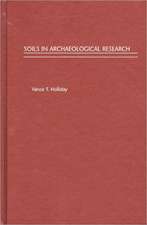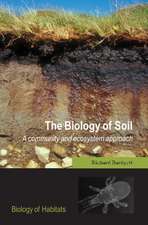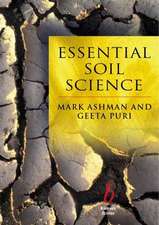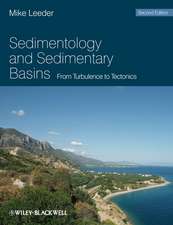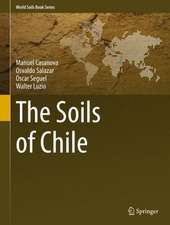The Geology of Stratigraphic Sequences
Autor Andrew D. Miallen Limba Engleză Paperback – 31 oct 2014
| Toate formatele și edițiile | Preț | Express |
|---|---|---|
| Paperback (1) | 546.41 lei 39-44 zile | |
| Springer Berlin, Heidelberg – 31 oct 2014 | 546.41 lei 39-44 zile | |
| Hardback (1) | 922.17 lei 3-5 săpt. | |
| Springer Berlin, Heidelberg – 20 apr 2010 | 922.17 lei 3-5 săpt. |
Preț: 546.41 lei
Preț vechi: 674.58 lei
-19% Nou
Puncte Express: 820
Preț estimativ în valută:
104.55€ • 109.75$ • 86.78£
104.55€ • 109.75$ • 86.78£
Carte tipărită la comandă
Livrare economică 07-12 aprilie
Preluare comenzi: 021 569.72.76
Specificații
ISBN-13: 9783642423062
ISBN-10: 364242306X
Pagini: 544
Ilustrații: XVII, 522 p.
Dimensiuni: 193 x 260 x 29 mm
Greutate: 1.14 kg
Ediția:2nd ed. 2010
Editura: Springer Berlin, Heidelberg
Colecția Springer
Locul publicării:Berlin, Heidelberg, Germany
ISBN-10: 364242306X
Pagini: 544
Ilustrații: XVII, 522 p.
Dimensiuni: 193 x 260 x 29 mm
Greutate: 1.14 kg
Ediția:2nd ed. 2010
Editura: Springer Berlin, Heidelberg
Colecția Springer
Locul publicării:Berlin, Heidelberg, Germany
Public țintă
Professional/practitionerCuprins
Contents
Part I
THE EMERGENCE OF MODERN CONCEPTS
1 HISTORICAL AND METHODOLOGICAL BACKGROUND
1.1 introduction
1.2 Methodologies in geology
1.2.2 The significance of sequence stratigraphy
1.2.3 Data and argument in Geology
1.2.4 The hermeneutic circle and the emergence of sequence stratigraphy
1.2.5 Paradigms and exemplars
1.3 The development of descriptive stratigraphy
1.3.1 The growth of modern concepts
1.3.2 Do stratigraphic units have "time" significance?
1.3.3 The development of modern chronostratigraphy
1.4 The continual search for a "pulse of the earth"
1.5 Problems and research trends: the current status
1.6 Current literature
1.7 Stratigraphic terminology
2 THE BASIC SEQUENCE MODEL
2.1 Introduction
2.2 Elements of the model
2.2.1 Accommodation and supply
2.2.2 Stratigraphic architecture
2.2.3 Depositional systems and systems tracts
2.3 Sequence models in clastic and carbonate settings
2.3.1 Marine clastic depositional systems and systems tracts
2.3.2 Nonmarine depositional systems
2.3.3 Carbonate depositional systems
2.3.3.1 Breaks in sedimentation in carbonate environments
2.3.3.2 Platform carbonates: catch-up versus keep-up
2.4 Sequence definitions
Figures
3 OTHER METHODS FOR THE STRATIGRAPHIC ANALYSIS OF CYCLES OF BASE-LEVEL CHANGE
3.1 Introduction
3.2 Facies cycles
3.3 Areas and volumes of stratigraphic units
3.4 Hypsometric curves
3.5 Backstripping
3.6 Sea-level estimation from paleoshorelines and other fixed points
3.7 Documentation of metre-scale cycles
3.8 Integrated tectonic-stratigraphic analysis
Figures
Part II
THE STRATIGRAPHIC FRAMEWORK
4 The major types of stratigraphic cycle <4.1 Introduction
4.2 Sequence hierarchy
4.3 The supercontinent cycle
4.4 Cycles with episodicities of tens of millions of years
4.5 Cycles with million-year episodicities
4.6 Cycles with episodicities of less than one million years
Tables
Figures
5 CYCLES WITH EPISODICITIES OF TENS TO HUNDREDS OF MILLIONS OF YEARS
5.1 Climate, sedimentation and biogenesis
5.2 The supercontinent cycle
5.2.1 The tectonic-stratigraphic model
5.2.2 The Phanerozoic record
5.3 Cycles with episodicities of tens of millions of years
5.3.1 Regional to intercontinental correlations
5.3.2 Tectonostratigraphic sequences
5.4 Main conclusions
Figures
6 CYCLES WITH MILLION-YEAR EPISODICITIES
6.1 Continental margins
6.1.1 Clastic platforms and margins
6.1.2 Carbonate cycles of platforms and craton margins
6.1.3 Mixed carbonate-clastic successions
6.2 Foreland basins
6.2.1 Foreland basin of the North American Western Interior
6.2.2 Other foreland basins
6.3 Arc-related basins
6.3.1 Forearc basins
6.3.2 Backarc basins
6.4 Cyclothems and mesothems
6.6 Conclusions
Figures
7 CYCLES WITH EPISODICITIES OF LESS THAN ONE MILLION YEARS 7.1 Introduction
7.2 Neogene clastic cycles of continental margins
7.2.1 The Gulf Coast basin of the United States
7.2.2 Wanganui Basin, North Island, New Zealand
7.2.3 Other examples of Neogene high-frequency cycles
7.2.4 The deep-marine record
7.3 Pre-Neogene marine carbonate and clastic cycles
7.4 Late Paleozoic cyclothems
7.5 Lacustrine clastic and chemical rhythms
7.6 High-frequency cycles in foreland basins
7.7 Main conclusions
Figures
Part III
MECHANISMS
8 SUMMARY OF SEQUENCE-GENERATING MECHANISMS
Figures
9 LONG-TERM EUSTASY AND EPEIROGENY
9.1 Mantle processes and dynamic topography
9.2 Supercontinent cycles
9.3 Cycles with episodicities of tens of millions of years
9.3.1 Eustasy
9.3.2 Dynamic topography and epeirogeny
9.3.3 The origin of Sloss sequences
9.4 Main conclusions
Figures
10 TECTONIC MECHANISMS
10.1 Introduction
10.2 Rifting and thermal evolution of divergent plate margins
10.2.1 Basic geophysical models and their implications for sea-level change
10.2.2 The origins of some tectonostratigraphic sequences
10.3 Tectonism on convergent plate margins and in collision zones
10.3.1 Magmatic arcs and subduction
10.3.2 Rates of uplift and subsidence on convergent margins
10.3.3 Tectonism versus eustasy in foreland basins
10.3.3.1 The North American Western Interior Basin;
10.3.3.2 The Appalachian foreland basin.
10.3.3.3 Pyrenean and Himalayan basins
10.4 Intraplate stress
10.4.1 The pattern of global stress
10.4.2 In-plane stress as a control of sequence architecture
10.4.3 In-plane stress and regional histories of sea-level change
10.5 Basement control
10.6 Sediment supply and the importance of big rivers
10.7 Environmental change
10.8 Main conclusions
Figures
11 ORBITAL FORCING 11.1 Introduction
11.2 The nature of Milankovitch processes
11.2.1 Components of orbital forcing
11.2.2 Basic climatology
11.2.3 Variations with time in orbital periodicities
11.2.4 Isostasy and geoid changes
11.2.5 Nonglacial Milankovitch cyclicity
11.2.6 The nature of the cyclostratigraphic data base
11.3 The geologic record
11.3.1 The sensitivity of the earth to glaciation
11.3.2 The Cenozoic record
11.3.3 Glacioeustasy in the Mesozoic?
11.3.4 Late Paleozoic cyclothems
11.4 Distinguishing between orbital forcing and tectonic driving mechanisms
11.5 Main conclusions
Figures
Part IV CHRONOSTRATIGRAPHY AND CORRELATION: AN ASSESSMENT OF THE CURRENT STATUS OF "GLOBAL EUSTASY"
12 THE CONCEPT OF THE GLOBAL CYCLE CHART
12.1 From Vail to Haq
12.2 The two-paradigm problem
12.3 Defining and deconstructing global eustasy and complexity texts
12.4 Invisible colleges and the advancement of knowledge
12.5 The global-eustasy paradigm—a revolution in trouble?
12.6 Conclusions
Figures
13 TIME IN SEQUENCE STRATIGRAPHY 13.1 Introduction
13.1 Hierarchies of time and the completeness of the stratigraphic record
13.2 Main conclusions
14 CHRONOSTRATIGRAPHY, CORRELATION, AND MODERN TESTS FOR GLOBAL EUSTASY 14.1 Introduction
14.2 Chronostratigraphic models and the testing of correlations
14.3 Chronostratigraphic meaning of unconformities
14.4 A correlation experiment
14.5 Testing for eustasy: the way forward
14.5.1 Introduction
14.5.2 The dating and correlation of stratigraphic events: potential sources of uncertainty
14.5.2.1 Identification of sequence boundaries
14.5.2.2 Chronostratigraphic meaning of unconformities
14.5.2.3 Determination of the biostratigraphic framework
14.5.2.4 The problem of incomplete biostratigraphic recovery.
14.5.2.5 Diachroneity of the biostratigraphic record.
14.5.3 The value of quantitative biostratigraphic methods
14.5.4 Assessment of relative biostratigraphic precision
14.5.5 Correlation of biozones with the global stage framework
14.5.6 Assignment of absolute ages and the importance of the modern time scale
14.6 Modern tests of the global eustasy paradigm
14.6.1 Cretaceous-Paleogene sequence stratigraphy of New Jersey
14.6.2 Other modern high-resolution studies of Cretaceous-Paleogene sequence stratigraphy
14.6.3 Sequence stratigraphy of the Neogene
14.6.4 The growing evidence for glacioeustasy in the Mesozoic and Cenozoic
14.7 Cyclostratigraphy and Astrochronology
14.7.1 Historical background of cyclostratigraphy
14.7.2 The building of a time scale
14.8 Main conclusions
Tables
Figures
15 FUTURE DIRECTIONS
15.1 Research methodology
15.2 Remaining questions
15.2.1 Future advances in cyclostratigraphy?
15.2.2 Tectonic mechanisms of sequence generation.
15.2.3 Orbital forcing
15.2.4 The codification of sequence nomenclature
Figures
Part I
THE EMERGENCE OF MODERN CONCEPTS
1 HISTORICAL AND METHODOLOGICAL BACKGROUND
1.1 introduction
1.2 Methodologies in geology
1.2.2 The significance of sequence stratigraphy
1.2.3 Data and argument in Geology
1.2.4 The hermeneutic circle and the emergence of sequence stratigraphy
1.2.5 Paradigms and exemplars
1.3 The development of descriptive stratigraphy
1.3.1 The growth of modern concepts
1.3.2 Do stratigraphic units have "time" significance?
1.3.3 The development of modern chronostratigraphy
1.4 The continual search for a "pulse of the earth"
1.5 Problems and research trends: the current status
1.6 Current literature
1.7 Stratigraphic terminology
2 THE BASIC SEQUENCE MODEL
2.1 Introduction
2.2 Elements of the model
2.2.1 Accommodation and supply
2.2.2 Stratigraphic architecture
2.2.3 Depositional systems and systems tracts
2.3 Sequence models in clastic and carbonate settings
2.3.1 Marine clastic depositional systems and systems tracts
2.3.2 Nonmarine depositional systems
2.3.3 Carbonate depositional systems
2.3.3.1 Breaks in sedimentation in carbonate environments
2.3.3.2 Platform carbonates: catch-up versus keep-up
2.4 Sequence definitions
Figures
3 OTHER METHODS FOR THE STRATIGRAPHIC ANALYSIS OF CYCLES OF BASE-LEVEL CHANGE
3.1 Introduction
3.2 Facies cycles
3.3 Areas and volumes of stratigraphic units
3.4 Hypsometric curves
3.5 Backstripping
3.6 Sea-level estimation from paleoshorelines and other fixed points
3.7 Documentation of metre-scale cycles
3.8 Integrated tectonic-stratigraphic analysis
Figures
Part II
THE STRATIGRAPHIC FRAMEWORK
4 The major types of stratigraphic cycle <4.1 Introduction
4.2 Sequence hierarchy
4.3 The supercontinent cycle
4.4 Cycles with episodicities of tens of millions of years
4.5 Cycles with million-year episodicities
4.6 Cycles with episodicities of less than one million years
Tables
Figures
5 CYCLES WITH EPISODICITIES OF TENS TO HUNDREDS OF MILLIONS OF YEARS
5.1 Climate, sedimentation and biogenesis
5.2 The supercontinent cycle
5.2.1 The tectonic-stratigraphic model
5.2.2 The Phanerozoic record
5.3 Cycles with episodicities of tens of millions of years
5.3.1 Regional to intercontinental correlations
5.3.2 Tectonostratigraphic sequences
5.4 Main conclusions
Figures
6 CYCLES WITH MILLION-YEAR EPISODICITIES
6.1 Continental margins
6.1.1 Clastic platforms and margins
6.1.2 Carbonate cycles of platforms and craton margins
6.1.3 Mixed carbonate-clastic successions
6.2 Foreland basins
6.2.1 Foreland basin of the North American Western Interior
6.2.2 Other foreland basins
6.3 Arc-related basins
6.3.1 Forearc basins
6.3.2 Backarc basins
6.4 Cyclothems and mesothems
6.6 Conclusions
Figures
7 CYCLES WITH EPISODICITIES OF LESS THAN ONE MILLION YEARS 7.1 Introduction
7.2 Neogene clastic cycles of continental margins
7.2.1 The Gulf Coast basin of the United States
7.2.2 Wanganui Basin, North Island, New Zealand
7.2.3 Other examples of Neogene high-frequency cycles
7.2.4 The deep-marine record
7.3 Pre-Neogene marine carbonate and clastic cycles
7.4 Late Paleozoic cyclothems
7.5 Lacustrine clastic and chemical rhythms
7.6 High-frequency cycles in foreland basins
7.7 Main conclusions
Figures
Part III
MECHANISMS
8 SUMMARY OF SEQUENCE-GENERATING MECHANISMS
Figures
9 LONG-TERM EUSTASY AND EPEIROGENY
9.1 Mantle processes and dynamic topography
9.2 Supercontinent cycles
9.3 Cycles with episodicities of tens of millions of years
9.3.1 Eustasy
9.3.2 Dynamic topography and epeirogeny
9.3.3 The origin of Sloss sequences
9.4 Main conclusions
Figures
10 TECTONIC MECHANISMS
10.1 Introduction
10.2 Rifting and thermal evolution of divergent plate margins
10.2.1 Basic geophysical models and their implications for sea-level change
10.2.2 The origins of some tectonostratigraphic sequences
10.3 Tectonism on convergent plate margins and in collision zones
10.3.1 Magmatic arcs and subduction
10.3.2 Rates of uplift and subsidence on convergent margins
10.3.3 Tectonism versus eustasy in foreland basins
10.3.3.1 The North American Western Interior Basin;
10.3.3.2 The Appalachian foreland basin.
10.3.3.3 Pyrenean and Himalayan basins
10.4 Intraplate stress
10.4.1 The pattern of global stress
10.4.2 In-plane stress as a control of sequence architecture
10.4.3 In-plane stress and regional histories of sea-level change
10.5 Basement control
10.6 Sediment supply and the importance of big rivers
10.7 Environmental change
10.8 Main conclusions
Figures
11 ORBITAL FORCING 11.1 Introduction
11.2 The nature of Milankovitch processes
11.2.1 Components of orbital forcing
11.2.2 Basic climatology
11.2.3 Variations with time in orbital periodicities
11.2.4 Isostasy and geoid changes
11.2.5 Nonglacial Milankovitch cyclicity
11.2.6 The nature of the cyclostratigraphic data base
11.3 The geologic record
11.3.1 The sensitivity of the earth to glaciation
11.3.2 The Cenozoic record
11.3.3 Glacioeustasy in the Mesozoic?
11.3.4 Late Paleozoic cyclothems
11.4 Distinguishing between orbital forcing and tectonic driving mechanisms
11.5 Main conclusions
Figures
Part IV CHRONOSTRATIGRAPHY AND CORRELATION: AN ASSESSMENT OF THE CURRENT STATUS OF "GLOBAL EUSTASY"
12 THE CONCEPT OF THE GLOBAL CYCLE CHART
12.1 From Vail to Haq
12.2 The two-paradigm problem
12.3 Defining and deconstructing global eustasy and complexity texts
12.4 Invisible colleges and the advancement of knowledge
12.5 The global-eustasy paradigm—a revolution in trouble?
12.6 Conclusions
Figures
13 TIME IN SEQUENCE STRATIGRAPHY 13.1 Introduction
13.1 Hierarchies of time and the completeness of the stratigraphic record
13.2 Main conclusions
14 CHRONOSTRATIGRAPHY, CORRELATION, AND MODERN TESTS FOR GLOBAL EUSTASY 14.1 Introduction
14.2 Chronostratigraphic models and the testing of correlations
14.3 Chronostratigraphic meaning of unconformities
14.4 A correlation experiment
14.5 Testing for eustasy: the way forward
14.5.1 Introduction
14.5.2 The dating and correlation of stratigraphic events: potential sources of uncertainty
14.5.2.1 Identification of sequence boundaries
14.5.2.2 Chronostratigraphic meaning of unconformities
14.5.2.3 Determination of the biostratigraphic framework
14.5.2.4 The problem of incomplete biostratigraphic recovery.
14.5.2.5 Diachroneity of the biostratigraphic record.
14.5.3 The value of quantitative biostratigraphic methods
14.5.4 Assessment of relative biostratigraphic precision
14.5.5 Correlation of biozones with the global stage framework
14.5.6 Assignment of absolute ages and the importance of the modern time scale
14.6 Modern tests of the global eustasy paradigm
14.6.1 Cretaceous-Paleogene sequence stratigraphy of New Jersey
14.6.2 Other modern high-resolution studies of Cretaceous-Paleogene sequence stratigraphy
14.6.3 Sequence stratigraphy of the Neogene
14.6.4 The growing evidence for glacioeustasy in the Mesozoic and Cenozoic
14.7 Cyclostratigraphy and Astrochronology
14.7.1 Historical background of cyclostratigraphy
14.7.2 The building of a time scale
14.8 Main conclusions
Tables
Figures
15 FUTURE DIRECTIONS
15.1 Research methodology
15.2 Remaining questions
15.2.1 Future advances in cyclostratigraphy?
15.2.2 Tectonic mechanisms of sequence generation.
15.2.3 Orbital forcing
15.2.4 The codification of sequence nomenclature
Figures
Recenzii
From the reviews of the second edition:
“In this new edition … Miall (Univ. of Toronto) examines in detail the results of Vail and his followers, showing where he agrees with those results and where he feels that the Vail/Exxon model has gone too far in extrapolating from these results. … A must-read book for those actively involved in stratigraphy. Summing Up: Highly recommended. Graduate students and above.” (C. W. Dimmick, Choice, Vol. 48 (5), January, 2011)
“The considerably expanded and updated second edition of this book is subdivided into four parts … . These four parts contain 15 chapters altogether. … the book is a most welcome update and overview of the rapidly developing field of sequence stratigraphy. All students and professional geologists working in basin analysis will certainly like to have it available in their private libraries. Considering the relatively low price, I can therefore wholeheartedly recommend it.” (T. J. A. Reijers, The Sedimentary Record,January, 2011)
“In this new edition … Miall (Univ. of Toronto) examines in detail the results of Vail and his followers, showing where he agrees with those results and where he feels that the Vail/Exxon model has gone too far in extrapolating from these results. … A must-read book for those actively involved in stratigraphy. Summing Up: Highly recommended. Graduate students and above.” (C. W. Dimmick, Choice, Vol. 48 (5), January, 2011)
“The considerably expanded and updated second edition of this book is subdivided into four parts … . These four parts contain 15 chapters altogether. … the book is a most welcome update and overview of the rapidly developing field of sequence stratigraphy. All students and professional geologists working in basin analysis will certainly like to have it available in their private libraries. Considering the relatively low price, I can therefore wholeheartedly recommend it.” (T. J. A. Reijers, The Sedimentary Record,January, 2011)
Caracteristici
Situates sequences within the broader context of geological processes so that geoscientists are better equipped to extract the maximum information from the record of sequences in a given basin or region Essential reading for professional geologists involved in coal, gas and petroleum geology as well as hydrology Stresses a deductive approach to geology placing the evidence before the model, making this a must read for all students of geology Includes supplementary material: sn.pub/extras

